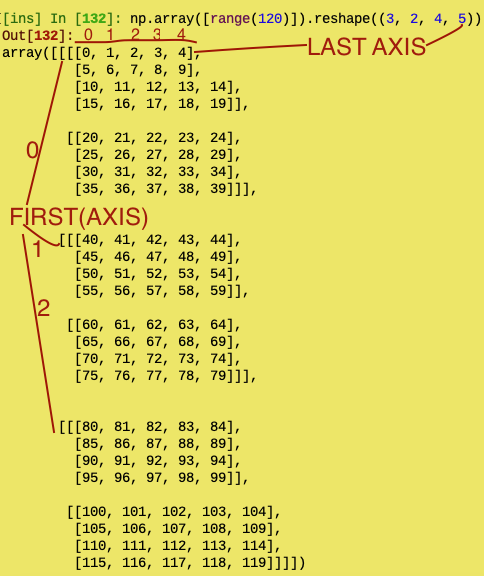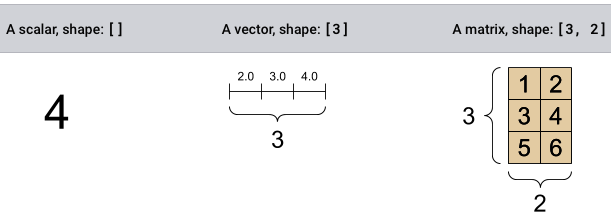SciTech-BigDataAIML-Tensorflow-Introduction to Tensors
https://tensorflow.google.cn/guide/tensor
TensorFlow supports eager execution and graph execution, and TensorFlow defaults to eager execution.:
- In eager execution, operations are evaluated immediately.
Note that during eager execution, you may discover yourTensorsare actually of typeEagerTensor. This is an internal detail. - In graph execution, a computational graph is constructed for later evaluation.
In TensorFlow,tf.functions are a common way to define graph execution. - Note: Typically, anywhere
a TensorFlow functionexpects
a Tensor as input, the function will also accept anything that can be converted to a Tensor usingtf.convert_to_tensor.
Introduction to Tensors
-
Tensorsaremulti-dimensional arrays with a uniform type(called
adtype). If you're familiar withNumPy, tensors are (kind of) likenp.arrays.
tf.dtypesincluded all supported dtypes:- To inspect a
tf.Tensor's data typeuse theTensor.dtypeproperty. - When creating a
tf.Tensorfroma Python objectyou may optionally specify the datatype. If you don't, TensorFlow chooses a datatype that can represent your data and convertsPython integerstotf.int32andPython floating point numberstotf.float32, Otherwise TensorFlowuses the same rules NumPy useswhen converting to arrays. - You can cast from type to type.
- Tensors and
tf.TensorShapeobjects have convenient properties for accessing these:
- To inspect a
-
All tensors are immutableandonly create a new one,
just like Python numbers and strings: you can never update the contents of a tensor.- Constants:
tf.constant( a function )
Thetf.stringdtype is used for all raw bytes data in TensorFlow.
Thetf.iomodule contains functions for converting data to and from bytes, including decoding images and parsing csv. - tf.Tensor( a class ): All eager
tf.Tensorvalues are immutable (in contrast totf.Variable).
Atf.Tensorrepresents a multidimensional array of elements.
All elements are of a single known data type.
When writing a TensorFlow program, the main object that is manipulated and passed around is thetf.Tensor. - Variables:
tf.Variable( a class type ) are immutable objects:
use a tf.Variable to store model weights( or other mutable state ) in TensorFlow. Since normal tf.Tensor objects are immutable.
- Constants:
tensorOfStrs = tf.constant(["Gray wolf", "Quick brown fox"])
# <tf.Tensor: shape=(3,), dtype=string,
# numpy=array([b'Gray wolf', b'Quick brown fox'], dtype=object)>
# it is OK if you have 3 string tensors of different lengths.
# Note: the shape is (3,). The string length is not included.
print(tf.strings.split(tensorOfStrs, sep=" "))
# <tf.RaggedTensor [[b'Gray', b'wolf'], [b'Quick', b'brown', b'fox']]>
tensorOfUnicodeStr = tf.constant("🥳👍")
# <tf.Tensor: shape=(), dtype=string,
# numpy=b'\xf0\x9f\xa5\xb3\xf0\x9f\x91\x8d'>
text = tf.constant("1 10 100")
tf.strings.to_number( tf.strings.split(text, " ") )
# <tf.Tensor: shape=(3,), dtype=float32, numpy=array([1.0, 10.0, 100.0], dtype=float32)>
byte_strings = tf.strings.bytes_split(tf.constant("Duck"))
# <tf.Tensor: shape=(4,), dtype=string, numpy=array([b'D', b'u', b'c', b'k'], dtype=object)>
tf.io.decode_raw(tf.constant("Duck"), tf.uint8)
# <tf.Tensor: shape=(4,), dtype=uint8, numpy=array([68, 117, 99, 107], dtype=uint8)>
var = tf.Variable([0.0, 0.0, 0.0])
var.assign([1, 2, 3]) # OR var = [1, 2, 3]
var.assign_add([1, 1, 1]) # NOT!: var += [1, 1 ,1]
var.assign_sub([1, 1, 1]) # NOT!: var -= [1, 1 ,1]
# Refer to the Variables guide for details.
the_f64_tensor = tf.constant([2.2, 3.3, 4.4], dtype=tf.float64)
# Now, cast to an float16
the_f16_tensor = tf.cast(the_f64_tensor, dtype=tf.float16)
# <tf.Tensor: shape=(3,), dtype=float16, numpy=array([2.199219, 3.300781, 4.398438], dtype=float16)>
# Now, cast to an uint8 and lose the decimal precision
the_u8_tensor = tf.cast(the_f16_tensor, dtype=tf.uint8)
# <tf.Tensor: shape=(3,), dtype=uint8, numpy=array([2, 3, 4], dtype=uint8)>
About shapes
Tensors have shapes represent the structure of a tensor.
Actually Tensors is a Hierarchical Organization of Data, they have ranks/layers from LOCAL to GLOBAL, each rank own corresponding WEIGHTS.
Some vocabulary:
-
Size: The total number of items in the tensor, the product of the shape vector's elements. -
Shape: The length (number of elements) of each of the axes of a tensor.- A Tensor's shape (that is, the rank of the Tensor and the size of each dimension) may not always be fully known.
Intf.functiondefinitions, the shape may only be partially known. - Most operations produce tensors of fully-known shapes if the shapes of their inputs are also fully known,
but in some cases it's only possible to find the shape of a tensor at execution time. - A number of specialized tensors are available: see
tf.Variable,tf.constant,tf.placeholder,tf.sparse.SparseTensor, andtf.RaggedTensor
- A Tensor's shape (that is, the rank of the Tensor and the size of each dimension) may not always be fully known.
-
Rank: Number of tensor axes:
Note: Although you may see reference to a "tensor of two dimensions", a rank-2 tensor does not usually describe a 2D space.- A scalar has rank 0,
- a vector has rank 1,
- a matrix is rank 2.
-
Axis(Dimension): A particular dimension of a tensor.The base tf.Tensor class requires tensors to be "rectangular"
--- that is,along each axis, every element is the same size.- Context of axes:
- ORG.: often axes are ordered from global to local:
The BATCH AXIS first, followed by spatial dimensions,
and FEATURES for LOCATION LAST. - INDEXING: While axes are often referred to by their indices, you should always keep track of the meaning of each.
- Single-axis indexing: TensorFlow follows standard Python indexing rules, similar to indexing a list or a string in Python, and the basic rules for NumPy indexing.
- indexes start at 0
- negative indices count backwards from the end
- colons(
:), are used for slices:start:stop:step
- Multi-axis indexing: Higher rank tensors
are indexed bypassing multiple indices.
The exact same rules as in the single-axis case apply to each axis independently.
- Single-axis indexing: TensorFlow follows standard Python indexing rules, similar to indexing a list or a string in Python, and the basic rules for NumPy indexing.
- IMPL.: This way feature vectors are contiguous regions of memory.
The data maintains its layout in memory and a new tensor is created, with the requested shape, pointing to the same data.
TensorFlow uses C-style "row-major" memory ordering, where incrementing the rightmost index corresponds to a single step in memory.
- ORG.: often axes are ordered from global to local:
- reshapping:
- You can reshape a tensor into a new shape. The tf.reshape operation is fast and cheap as the underlying data does not need to be duplicated.
- Typically the only reasonable use of tf.reshape is to combine or split adjacent axes (or add/remove 1s).
np.array([range(6)]).reshape([1, 2, 3])
=> array([[[0, 1, 2], [3, 4, 5]]])np.array([range(6)]).reshape([1, 2, 3]).reshape([-1])
=> array([0, 1, 2, 3, 4, 5])



However, there are specialized types of tensors that can handle different shapes:
Ragged tensors(see RaggedTensor below)Sparse tensors(see SparseTensor below)
You can convert sparse tensors to dense by usingtf.sparse.to_dense`ragged_tensor = tf.ragged.constant( [ [0, 1, 2, 3], [4, 5], [6, 7, 8], [9] ] )` `# <tf.RaggedTensor [[0, 1, 2, 3], [4, 5], [6, 7, 8], [9]]>` `print(ragged_tensor.shape)` `# TensorShape([4, None])` tensorOfStrs = tf.constant( ["Gray wolf", "Quick brown fox"] ) tf.strings.split( tensorOfStrs, sep=" ") # <tf.RaggedTensor [[b'Gray', b'wolf'], [b'Quick', b'brown', b'fox']]> # Sparse tensors store values by index in a memory-efficient manner sparse_tensor = tf.sparse.SparseTensor( indices=[ [0, 0], [1, 2] ], values=[1, 2], dense_shape=[3, 4] ) print(sparse_tensor, "\n") # SparseTensor( indices= tf.Tensor([ [0 0] [1 2] ], shape=(2, 2), dtype=int64), values= tf.Tensor([1 2], shape=(2,), dtype=int32), dense_shape= tf.Tensor([3 4], shape=(2,), dtype=int64) ) print(tf.sparse.to_dense(sparse_tensor)) # tf.Tensor( [ [1 0 0 0], [0 0 2 0], [0 0 0 0] ], shape=(3, 4), dtype=int32)
Math on Tensors:
You can do math on tensors, including addition, element-wise multiplication, and matrix multiplication.
a = tf.constant([ [1, 2], [3, 4] ])
b = tf.ones([2,2], dtype=tf.int32) # tf.constant([ [1, 1], [1, 1] ])
tf.add(a, b) # equals: a + b # element-wise addition
tf.multiply(a, b) # equals: a * b # element-wise multiplication
tf.matmul(a, b) # equals: a @ b # matrix multiplication
Tensors are used in all kinds of operations (or "Ops").
c = tf.constant([[4.0, 5.0], [10.0, 1.0]])
print(tf.reduce_max(c)) # Find the largest value
print(tf.math.argmax(c)) # Find the index of the largest value
print(tf.nn.softmax(c)) # Compute the softmax
tf.Tensor(10.0, shape=(), dtype=float32)
tf.Tensor([1 0], shape=(2,), dtype=int64)
tf.Tensor([ [2.6894143e-01 7.3105854e-01], [9.9987662e-01 1.2339458e-04] ], shape=(2, 2), dtype=float32)



 浙公网安备 33010602011771号
浙公网安备 33010602011771号